Among all the fruity stews we have in Iran, Khorsh-e Beh a is the most popular dish of them all. Persian quince stew, so-called Khoresh-e Beh, always reminds me of family dinners on cold days of autumn. The experience of Khoresh-e Beh with the great taste of soft-cooked quince in the mouth is unforgettable.
Everything about this dish comes from the magnificent aroma of Beh( the Persian word for quince). The best quince is grown in the city of Esfahan. Therefore this stew is originally an Esfahani dish.
Quince has a significant place in Persian cuisine whether as Khoresh-e Beh, elegant rich fragrant quince jam to hart warming quince tea.
What you need to know about Quince:
Quince is native to western Asia, Greece and Iran. It’s appearance resemble a comically shaped pear, bumpy and round in the middle. The skin is thin and easily bruised and blemished, and before cooking, most quince flesh is creamy white in colour, with a core inside just like an apple or pear.
Quince change colour from green to bright golden-yellow when matures in late autumn. The heady aroma of a golden quince is spicy and complex, with hints of apple, pear, and citrus. When its hard, tart flesh is cooked, quince becomes soft and dense and develops a sweet, slightly piquant flavour with a richer perfume.
Cooking quince turns the fruit’s flesh from creamy white to anywhere from a light rosy pink to a deep, dusky red. It is According to food science, this is because heat forms anthocyanins, natural pigments can appear red in colour.
The nutritional benefits of quince are enormous, it has a very low-calorie density, and high in Vitamin C, zinc, iron, copper, iron, potassium and fibre. Its history as a herbal supplement and medicine shows it has been useful as a gastrointestinal aid, skin and hair enhancer. As it’s beneficial in lowering blood pressure and may help heart disease, you would want to add it to your next healthy grocery shopping.
In traditional Persian medicine, quince is used for digestive disorders including stomach pain and gastrointestinal inflammation. Quince seeds steep in hot water are also used for cough and sore throat.
Quince’s assertive flavour and floral aroma pair are well with cinnamon, cardamom, vanilla, almonds, cream, and salty cheeses like Stilton, Ptarmigan.
It’s fine to leave quince out on the counter for a few days. Or wrap them loosely in plastic and pop them in the fridge for storing up to several weeks.
What is Khoresh-e Beh?
Throughout history, quince has been used widely in Persian cuisine because of its aroma and special fragrance. However, it has found its way into western cuisine over time as it has become more convenient to find it.
Khoresh/Khoresht (stew) is a big part of Persian cuisine and is usually served with Persian rice. There is a variety of different types of stews in different parts of Iran. Here are some other Persian stews recipes:
- Fesenjan – Persian Chicken Stew with Pomegranate Molasses
- Ghormeh sabzi – Persian Herb Stew
- Khoresh-E Gheyme Bademjan – Persian Yellow Split Peas and Aubergine Stew
- Khoresh Karafs – Persian Celery Stew
- Torshvash – Northern Iranian Sour Stew
- Morgh-e Torsh – Persian Sour Chicken and Green Herb Stew
I live in Canada and I see in my everyday life that most of the big grocery stores sell quince around December to March. In Iran, Quince or so-called Beh is so popular that it is farmed widely and lasts longer from early autumn to early spring, therefore Khoresh-e-Beh is considered as late autumn, early winter dish.
Vegetarian Khoresh-e Beh | Persian quince stew
Clearly the main taste of this dish comes from quince, and lamb would just be a good compliment. Also, the flavour of lamb might not be everyone’s favourite. However, you can use beef or simply leave the meat out, and replace the water with vegetable stock to give it more richness in flavour and serve it as a delicious vegetarian/ vegan meal.
What do you need to make Khorsh-e Beh?
like all other Persian dishes are cooked with a little different in each and every part of the country, Khoresh-e Beh is no exception. Some people make it with Saffron and some also add tomato paste. You may find Yellow split peas or even Pomegranate molasses in some recipes.
However, The main ingredients would stay the same. Quince (chopped), stew cut Lamb, onion, Dried plums. Turmeric, cinnamon and Saffron as it’s spice palette along with a mixture of lemon and sugar to give a tarty taste.
How to make Persian quince stew
Preparing quince
When buying quince look for the ones that are more bright and yellow and have a richer fragrance.
To prepare quince, use a sharp knife to cut them into quarters. Spoon out the seeds and hard white part of the middle. (Don’t forget to keep the seeds, as I mentioned earlier they are the remedy to sore throat and cough, and will come handy in autumn.)
Carefully slice the quince in approximately 1cm thickness (anything thinner might lose its texture while cooking). You can squeeze a little lemon juice over the quince slices, as it would help keep them from changing colour.
Cooking Khoresh-e Beh
In a large pan heat some vegetable oil and sauté chopped onions.
*For a tastier stew, it is important to sautee the onions very well until they become translucent and just beginning to change colour.
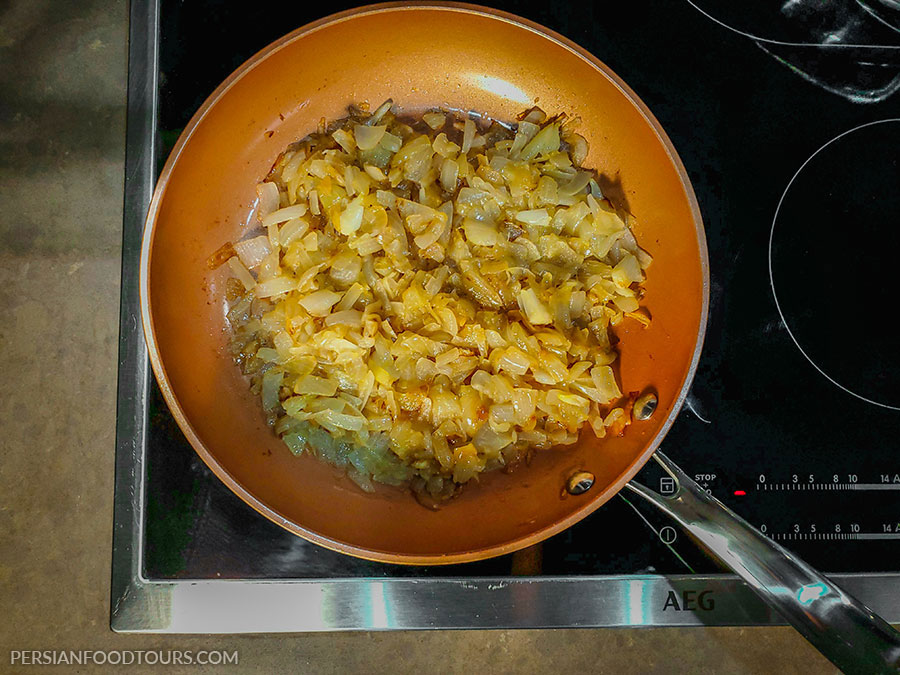
Add the meat and Turmeric, stirring them well together.
Fry until the meat is seared on all sides.
*If you decide to add yellow split peas to the stew, now would be the right time. Just wash and soak them for 2 hours ahead.
*You can also add 1/2 Tsp cardamom powder and an inch of cinnamon stick to enhance its flavour and aroma.
Add dried plums and just enough boiling water to cover the meat, lower the heat and let it simmer for 45 minutes or until meat is fully cooked.
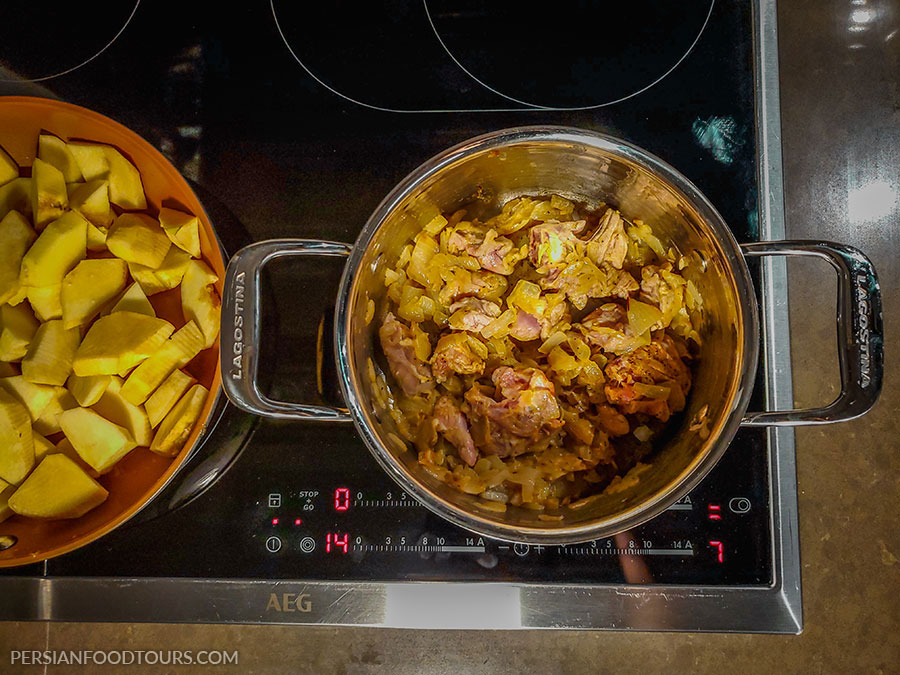
Meanwhile, Sauté quince slices in a different pan over medium heat until golden brown. Be careful as quince slices would burn quite fast.
Add the sauteed quinces to the pot when meat is fully cooked and tender. lemon juice and sugar would help the sweet-sour taste it needs.
Season with salt and pepper And simmer for 10 more minutes.
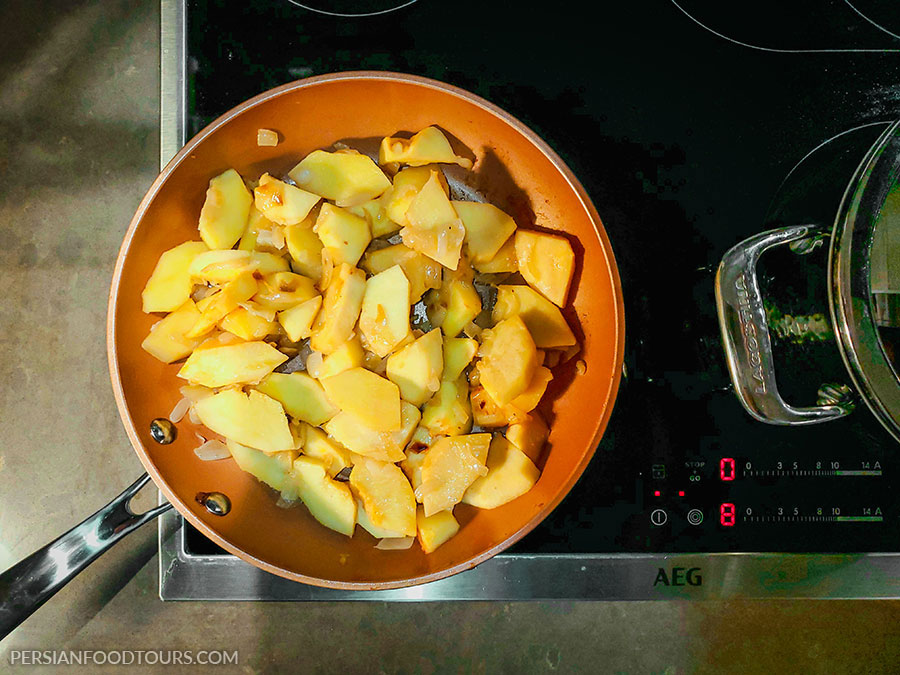
Saffron is the last ingredient to be added to infuse the stew with more flavour, colour and aroma. cover and cook for 15 minutes more on low heat until the flavours come together.
The traditional way to serve Khoresh-e Beh, like just about any other Persian stew, is with Persian steamed rice and most Sabzi Khordan as it’s side dish.
Nooshe-e Jan!
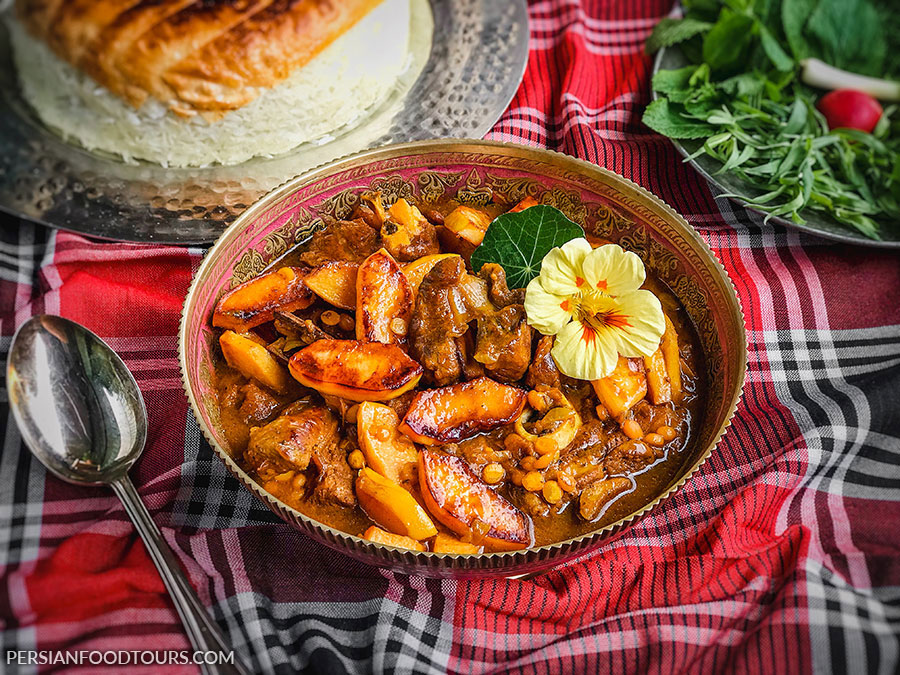
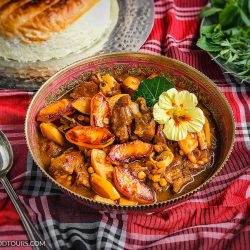
Khoresh-e Beh | Persian quince stew
Ingredients
- 2 Large Quince
- 1 Large Onions
- 500 g stew cut lamb
- 1 Tbsp Turmeric
- 1/2 Tsp cardamom powder optional
- 1 inch cinnamon stick optional
- 10 Dried plums soaked
- 100 g Yellow split peas optional
- 2-3 Tbsp Lemon juice
- 1-2 Tbsp Sugar
- 2 Tbsp bloomed Saffron
- Salt and Pepper
- Vegetable oil
- water
Instructions
- sauté chopped onions In a large pan over medium heat in vegetable until translucent.
- Add the meat along spices and fry them well together.
- Add split peas, dried plums and just enough boiling water to cove the meat.
- lower the heat and let it simmer of 45 minutes or until meat is fully cooked.
- Sauté quince slices in a different pan over medium heat until golden brown.
- Add the sauteed quinces to the pot when meat is well tender.
- Mix and pure lemon juice and sugar to give a sweet-sour taste.
- Season with salt and pepper and simmer for 10 more minutes.
- Add bloomed Saffron to infuse the stew with more flavour, colour and aroma.
- Let the stew simmer on low heat for 15 minutes more before serving.
Notes



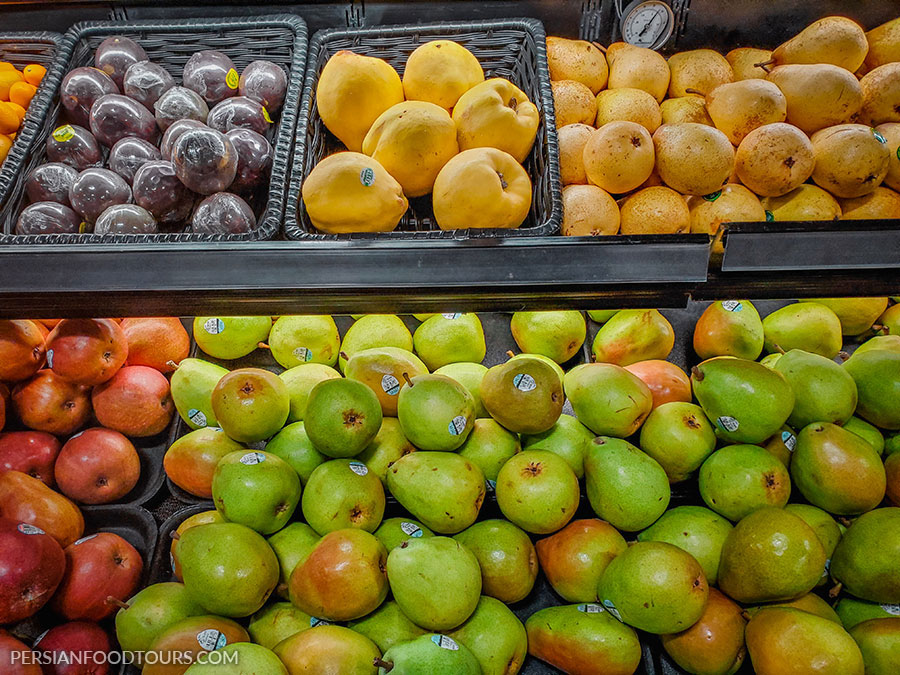
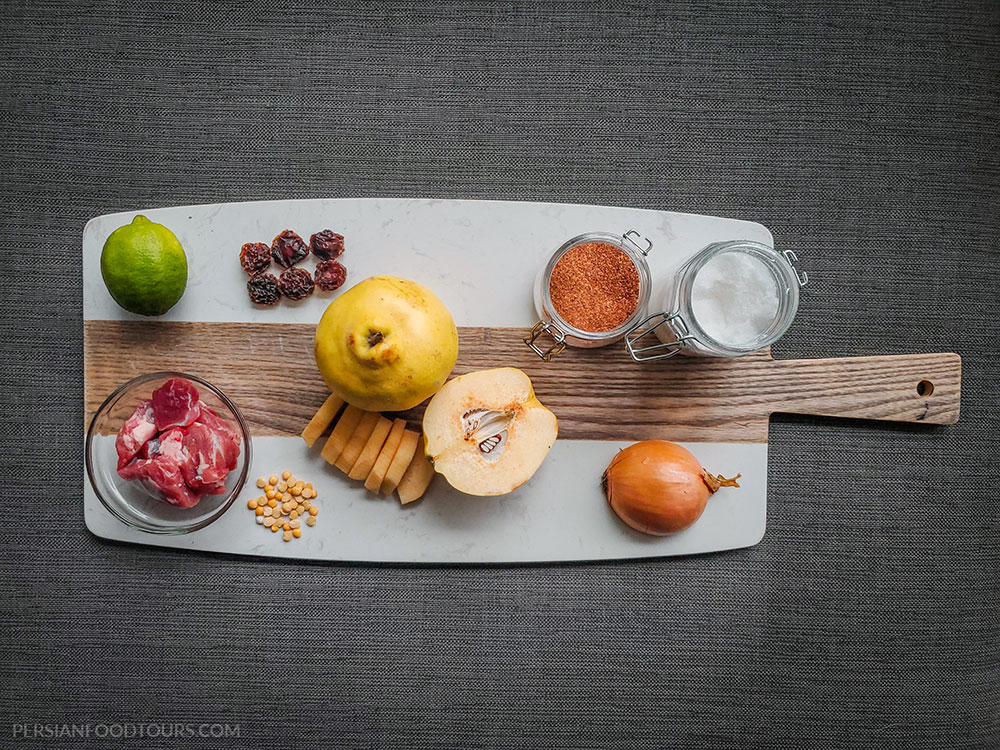


Comment (0)